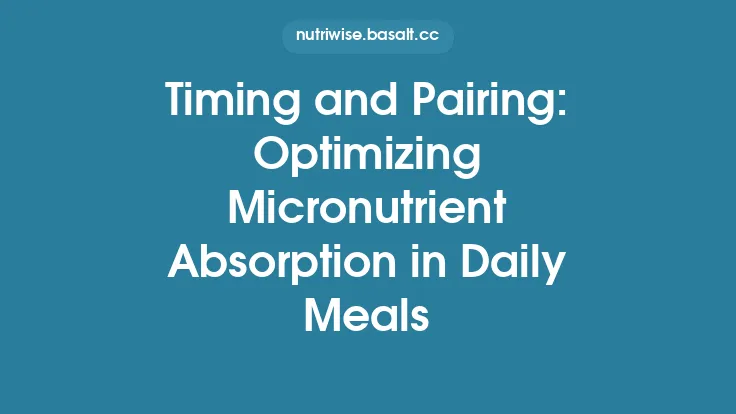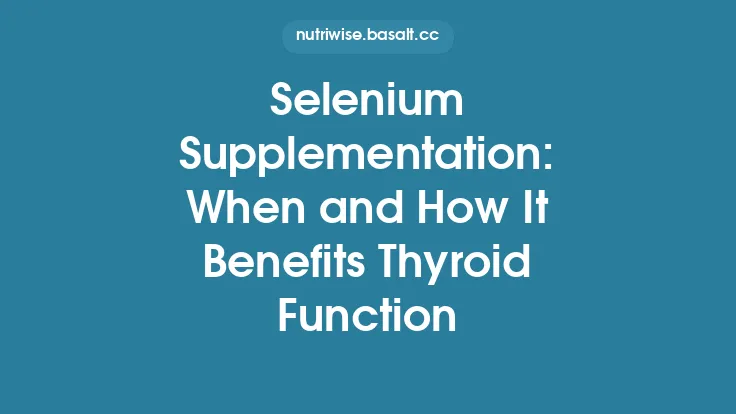When you swallow a supplement, its journey from the mouth to the bloodstream is profoundly shaped by what you’ve just eaten—or plan to eat. Food can act as a catalyst, a barrier, or even a chemical partner, altering the rate and extent to which active ingredients become available to your cells. Understanding these interactions helps you design meal‑supplement pairings that support optimal bioavailability without compromising the nutritional goals of your diet.
1. The Physicochemical Landscape of the Gastrointestinal Tract
The gastrointestinal (GI) environment is a dynamic system where pH, enzymes, bile salts, and transit time fluctuate throughout the digestive process. Each of these variables can either facilitate or hinder the dissolution of a supplement’s matrix and the subsequent absorption of its active constituents.
| GI Parameter | Typical Range | Influence on Supplements |
|---|---|---|
| Stomach pH | Fasted: 1–2; Fed: 3–5 | Acid‑labile compounds (e.g., vitamin C, certain probiotics) may degrade in a highly acidic fasted stomach but are protected when food raises pH. |
| Gastric Emptying Time | 30 min (liquid) – 2 h (solid) | Slow emptying prolongs exposure to gastric acid, which can increase degradation of acid‑sensitive nutrients but also allow more time for dissolution of enteric‑coated tablets. |
| Bile Salt Concentration | Low (fasted) – High (post‑prandial) | Bile salts emulsify lipids, crucial for the micellar solubilization of fat‑soluble vitamins (A, D, E, K) and certain lipophilic phytochemicals (e.g., curcumin). |
| Intestinal Enzyme Activity | Relatively constant, but up‑regulated after meals | Enzymes such as pancreatic lipase, proteases, and brush‑border peptidases can hydrolyze pro‑drugs or release bound minerals from chelates. |
By aligning supplement formulation characteristics (e.g., enteric coating, particle size, solubility) with these physiological states, you can predict how a meal will modulate absorption.
2. Macronutrient‑Driven Modulation of Bioavailability
2.1. Dietary Fat: The Primary Driver for Lipophilic Compounds
Fat acts as a solubilizing agent for lipophilic nutrients. When a meal contains 5–10 g of dietary fat, bile secretion is stimulated, forming mixed micelles that ferry fat‑soluble vitamins and certain phytochemicals across the unstirred water layer of the intestinal epithelium.
- Practical Example: A 1000 IU vitamin D3 capsule taken with a breakfast containing 1 egg, avocado, or a drizzle of olive oil can increase serum 25‑OH‑D levels by up to 30 % compared with taking the same capsule on an empty stomach.
- Mechanistic Insight: Micelles encapsulate the vitamin, protecting it from precipitation and enabling passive diffusion or carrier‑mediated uptake (e.g., NPC1L1 for cholesterol‑derived molecules).
2.2. Carbohydrates and Glycemic Load
High‑glycemic meals accelerate gastric emptying and stimulate insulin release, which can influence the transport of certain minerals and amino‑acid‑based supplements.
- Iron: Post‑prandial insulin spikes up‑regulate the expression of divalent metal transporter‑1 (DMT1) in enterocytes, modestly enhancing non‑heme iron absorption when the carbohydrate load is moderate (30–50 g). However, excessive simple sugars may compete for transport via the GLUT2 pathway, reducing iron uptake.
- Amino‑Acid Supplements: Rapid glucose absorption can increase splanchnic blood flow, potentially improving the first‑pass uptake of free amino acids.
2.3. Protein: A Double‑Edged Sword
Protein can both aid and impede supplement absorption:
- Facilitation: Certain peptide transporters (PEPT1) recognize di‑ and tripeptides, allowing peptide‑bound minerals (e.g., zinc‑glycinate) to be absorbed more efficiently than inorganic salts.
- Inhibition: High‑protein meals increase the secretion of gastric acid and pepsin, which may degrade acid‑labile probiotics or cause precipitation of calcium salts, reducing their solubility.
3. Micronutrient Interactions Within Meals
3.1. Calcium and Iron: Competitive Absorption
Calcium and non‑heme iron share the DMT1 transporter. Consuming a calcium‑rich dairy product (e.g., milk, cheese) within 2 hours of an iron supplement can reduce iron absorption by 30–50 %. The effect is dose‑dependent and more pronounced with high calcium intakes (>500 mg).
Guideline: Separate calcium‑dense foods from iron supplementation by at least 2 hours, or use iron formulations chelated to amino acids (e.g., iron‑bisglycinate) that bypass DMT1 competition.
3.2. Vitamin C and Polyphenols: Enhancers and Inhibitors
- Vitamin C acts as a potent reducer, converting ferric (Fe³⁺) to ferrous (Fe²⁺) iron, dramatically improving non‑heme iron absorption. Pairing a vitamin C‑rich fruit (e.g., orange, kiwi) with an iron supplement can double uptake.
- Polyphenols (found in tea, coffee, cocoa) bind iron and zinc, forming insoluble complexes that hinder absorption. A cup of black tea taken concurrently with a multivitamin can cut iron absorption by up to 60 %.
3.3. Magnesium and Phosphorus: The Phosphate Buffer
High dietary phosphorus (common in processed foods and sodas) can precipitate magnesium as magnesium phosphate, especially when the intestinal pH is alkaline (post‑prandial). This reduces the bioavailability of magnesium oxide or carbonate supplements.
Practical Tip: Opt for magnesium citrate or glycinate, which remain soluble across a broader pH range, and avoid taking magnesium supplements with phosphorus‑heavy meals.
4. The Role of Food Matrix and Physical Form
4.1. Whole Foods vs. Isolated Nutrients
Whole foods provide a matrix of fibers, phytochemicals, and macronutrients that can modulate the release and transport of supplemented nutrients.
- Fiber: Soluble fiber (e.g., pectin) can form viscous gels, slowing gastric emptying and potentially enhancing the dissolution of poorly water‑soluble tablets. Conversely, insoluble fiber may bind minerals, reducing their absorption.
- Phytates: Present in legumes, nuts, and whole grains, phytates chelate zinc, iron, and calcium, forming complexes that are poorly absorbed. Soaking, sprouting, or fermenting these foods reduces phytate content and mitigates the inhibitory effect.
4.2. Particle Size and Surface Area
Micronized or nano‑sized supplement particles have a larger surface area, facilitating faster dissolution even in the presence of food. For example, nano‑curcumin formulations demonstrate a 5‑fold increase in plasma levels when taken with a low‑fat meal compared with standard curcumin powder.
4.3. Enteric Coatings and Delayed‑Release Technologies
Enteric‑coated capsules are designed to resist gastric acid and dissolve in the more neutral pH of the small intestine. When taken with a high‑fat meal, the delayed gastric emptying can postpone the release of the active ingredient, potentially shifting the absorption window. Understanding the intended release site is essential for aligning meal composition accordingly.
5. Practical Meal‑Supplement Pairing Strategies
| Goal | Recommended Meal Composition | Timing Relative to Supplement |
|---|---|---|
| Maximize fat‑soluble vitamin uptake | 5–10 g of healthy fats (e.g., olive oil, nuts, avocado) + moderate protein | Take supplement with the meal |
| Enhance non‑heme iron absorption | Vitamin C‑rich fruit or juice (≥100 mg ascorbic acid) + low‑calcium, low‑polyphenol foods | Take iron with vitamin C source, avoid dairy/tea within 2 h |
| Improve magnesium bioavailability | Low‑phosphorus, moderate‑protein meal; include a source of citric acid (e.g., lemon) | Take magnesium with or shortly after the meal |
| Limit calcium‑iron competition | Separate calcium‑rich foods (dairy, fortified cereals) from iron supplement | Maintain a ≥2 h gap between calcium intake and iron supplementation |
| Support probiotic survival | Light, low‑acid meal (e.g., plain yogurt, oatmeal) | Take probiotic 30 min before a small meal or with a low‑acid snack |
| Optimize polyphenol‑rich supplement (e.g., green tea extract) | Minimal concurrent iron or zinc sources; avoid high‑calcium foods | Take between meals or with a low‑mineral snack |
6. Special Considerations for Populations with Altered Digestion
6.1. Older Adults
Age‑related reductions in gastric acid (hypochlorhydria) can impair the dissolution of certain mineral salts (e.g., calcium carbonate). Pairing these supplements with a modest amount of protein‑rich food can stimulate gastric secretions, partially compensating for the acid deficit.
6.2. Athletes and High‑Intensity Trainers
Intense exercise accelerates gastric emptying and increases intestinal permeability. Consuming a carbohydrate‑protein snack (≈30 g carbs, 10 g protein) within 30 minutes post‑workout can create a favorable environment for rapid uptake of branched‑chain amino acid (BCAA) supplements and electrolytes.
6.3. Individuals with Gastrointestinal Disorders
Conditions such as celiac disease, inflammatory bowel disease, or short‑bowel syndrome alter surface area and transporter expression. In these cases, using liquid or sublingual formulations bypasses the compromised intestinal segment, and pairing with easily digestible, low‑fiber meals reduces transit variability.
7. Summary of Key Takeaways
- Food composition matters: Fat, protein, carbohydrate, and specific micronutrients each exert distinct influences on supplement dissolution and transport.
- Timing is contextual: Align supplement intake with the post‑prandial physiological state that best supports its absorption pathway (e.g., bile‑rich phase for lipophilic compounds).
- Beware of antagonists: Calcium, phytates, polyphenols, and high phosphorus can impede the uptake of certain minerals; strategic separation or formulation choice mitigates these effects.
- Leverage the matrix: Whole‑food components (fiber, acids, enzymes) can be harnessed to enhance or protect supplement bioavailability when used intentionally.
- Tailor to the individual: Age, activity level, and gut health modify the GI environment; personalized meal‑supplement pairings yield the most consistent results.
By viewing each supplement as a chemical traveler navigating the complex terrain of the digestive system, you can design meals that act as friendly guides rather than obstacles—ensuring that the nutrients you invest in truly reach the cells that need them.





